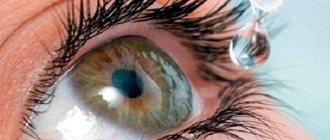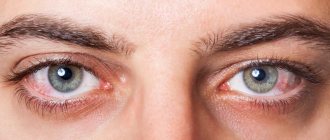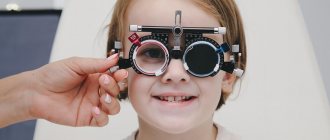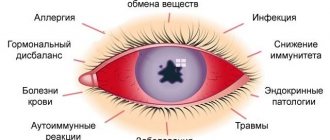The outside of the human eye is covered with a thin transparent tissue - the conjunctiva. This is the mucous membrane, which contains many thin blood vessels. If the vessels dilate for any reason, redness of the eye may occur, which is noticeable from the outside. But it also happens that they not only expand, but burst.
Find your nearest optical store
When blood enters the space between the conjunctiva and the sclera (the white layer of the eye), from the outside it looks as if the eye is completely or partially filled with blood. This makes an intimidating impression. However, such hemorrhage itself does not cause pain or visual impairment. A person may not feel anything at all and continue to lead a normal life, doing everyday activities, until others tell him what his eyes look like, or until he looks at himself in the mirror. However, a burst vessel can cause pain. In this case, you should definitely visit a doctor
.
A red spot in the eye due to pressure may take some time to resolve. But even if such a hemorrhage does not entail any health consequences, it is still unpleasant. What if you need to speak in front of an audience, go on a romantic date, or meet with business partners? It is not surprising that many people are concerned about the question: if a vessel in the eye bursts, what drops will help?
Why did a blood vessel burst in the eye?
The blood vessels in the conjunctiva are very thin and fragile. There are many reasons why eye vessels can burst. This:
- a sharp increase in blood pressure - usually in this case, single vessels burst, so the hemorrhage will be pinpoint;
- severe vomiting;
- an acute attack of glaucoma - an eye disease, the characteristic feature of which is an increase in intraocular pressure;
- inflammatory eye diseases - bacterial or viral conjunctivitis, keratitis, blepharitis;
- sudden physical activity, such as lifting heavy weights;
- long-term use of blood thinning medications;
- injuries - bruises, foreign objects getting into the eyes;
- complications after ophthalmic surgery.
The likelihood that blood vessels in the eye may burst increases due to certain age-related and chronic diseases. For example, with atherosclerosis and diabetes, the walls of blood vessels become thinner and tear easily.
A lack of vitamins can also lead to the walls of blood vessels becoming thinner and more easily torn with increased blood pressure or increased physical activity.
Our doctors who will solve your vision problems:
Fomenko Natalia Ivanovna
Chief physician of the clinic, ophthalmologist of the highest category, ophthalmic surgeon. Surgical treatment of cataracts, glaucoma and other eye diseases.
Yakovleva Yulia Valerievna Refractive surgeon, specialist in laser vision correction (LASIK, Femto-LASIK) for myopia, farsightedness and astigmatism.
You can find out the cost of a particular procedure or make an appointment at the Moscow Eye Clinic by phone or using the online appointment form.
Be sure to consult an ophthalmologist
The most common type of hemorrhage caused by burst vessels is hyposphagma, that is, the outpouring of blood into the space between the conjunctiva and the sclera. This phenomenon most often occurs due to increased physical activity or due to increased blood pressure. Most often, it goes away on its own, but it is still worth contacting an ophthalmologist, especially since without examination by a specialist you will not be able to determine the nature of the hemorrhage on your own.
Find your nearest optical store
The fact is that extensive hemorrhage may be a sign of a much more serious problem. Due to increased arterial or intraocular pressure, ruptures or detachment of the retina, which can be caused, for example, by a strong blow to the head, the vessels of the iris or ciliary body of the eye may burst, and retinal hemorrhage may occur. All this can lead to loss of vision, so an ophthalmologist must perform examinations and determine the nature of the damage, as well as the degree of its severity. In some cases, surgical intervention may be necessary, for example, removal of blood from the anterior chamber or vitreous body, laser coagulation of the retina aimed at removing breaks.
Be sure to consult an ophthalmologist
You should contact a specialist as soon as possible if:
- hemorrhage is accompanied by painful sensations;
- blood vessels burst not only in the eye (for example, hemorrhage in the eye is accompanied by bleeding gums);
- blood vessels burst in both eyes.
If you are taking blood thinners and have a ruptured blood vessel in your eye, you should also consult a doctor.
.
Diagnostic examination
The most important recommendation in case of a blow to the eye is to undergo a full diagnostic examination. After this, adequate effective treatment is possible. In this case, an ophthalmological examination includes:
- Visual inspection;
- Establishment of visual acuity;
- Determination of corneal sensitivity;
- Measuring intraocular pressure.
These are only the main, mandatory measures, but there may be several more of them, depending on the results of the initial examination. Often, there is a need to consult other specialists:
- Therapist;
- Traumatologist;
- Surgeon;
- Neurosurgeon.
How to get rid of eye redness due to burst blood vessels
With hyposphagma, as a rule, no special treatment is required. When bleeding into the space between the conjunctiva and sclera, most often it is enough to simply wait until the red spot resolves. Unfortunately, this takes several days, and there are no remedies that give an immediate effect and help get rid of the hemorrhage immediately.
However, you still need to contact an ophthalmologist. The fact is that burst blood vessels can indicate various diseases, as well as the fact that you need to change your lifestyle. The specialist will conduct an examination and, if necessary, prescribe treatment.
An ophthalmologist may recommend eye drops or other medications that have a good absorption effect. The dosage is determined for each patient individually and is usually 1-2 drops 2-4 times a day for 10-15 days.
Also, if you have a burst vessel, it is necessary to eliminate the causes and prescribe treatment. Examples of possible sources of illness:
- if the cause is inflammatory eye diseases, a specialist may prescribe eye drops with antiviral or anti-inflammatory effects;
- if the blood vessels burst due to increased physical activity during training, the doctor may advise you to temporarily stop active exercise;
- if the cause is high blood pressure or general diseases of the body, the ophthalmologist will recommend contacting the appropriate specialists.
Find your nearest optical store
Typically, a red spot in the eye will completely resolve within about 7-10 days. But on the first or second day after you notice the hemorrhage, you may experience that its area will increase. This is not usually caused by the bleeding continuing. It’s just that the blood that gets between the conjunctiva and the sclera is redistributed, the thickness of the clot decreases, and the area increases. After some time, the growth of the spot will stop, and it will gradually begin to decrease.
Classification of eye injuries
In ophthalmology, it is customary to distinguish types of eye injuries according to their severity:
- Lightweight, not affecting vision function;
- Moderate, leading to a short-term decrease in vision function;
- Severe, leading to a sustainable decrease in visual functions;
- Particularly severe, leading to loss of vision or the entire eye.
Any type of injury can be caused by a simple blow caused by a hand or some other object. And it is not at all necessary that the blow will be intentional.
What not to do if blood vessels in the eye burst
First of all, you should not self-medicate. You should not go to the pharmacy and consult a pharmacist about what drops you need if a blood vessel has burst. You risk not only choosing an ineffective remedy, but also worsening your eye condition. Do you need eye drops, and if so, which ones and in what quantity to instill them - all this should be discussed with an ophthalmologist. For questions related to wearing contact lenses, you should also consult a specialist.
Also, if a blood vessel has burst in your eye, you should not:
- touching the eye and especially rubbing it - this can increase hemorrhage;
- rinse the eye - this can also cause increased hemorrhage;
- continue to wear contact lenses - they will have to be removed;
- make warm lotions, for example with tea or herbal decoctions;
- use traditional medicine recipes from the Internet.
Treatment methods
The attending physician will tell you more precisely how to treat a red eye injured by a blow. But the traditional treatment regimen looks something like this:
1. Immediately after injury, it is necessary to rinse the eye and surrounding surfaces with disinfectant eye drops. 2. If severe pain occurs, you should take painkillers and go to the emergency room. 3. As a rule, in such cases the doctor prescribes hemostatic drugs, as well as calcium and iodine. 4. Severe cases of such injuries require bed rest.
Prevention of ruptured blood vessels
To reduce the likelihood that you will one day experience the problem of a red eye due to a burst blood vessel, you can take the following preventive measures:
- Try to avoid increased physical activity. If you are involved in sports or fitness, follow the recommendations of your trainer or instructor to avoid overexertion.
- Monitor your health and promptly treat diseases that may result in bleeding in the eye.
More attention should be paid to nutrition. Many foods contain vitamins that can improve blood circulation in the eyes. It is especially important to consume foods that contain vitamins P. In combination with ascorbic acid (vitamin C), they can reduce the permeability and fragility of blood vessels and improve their elasticity. Such vitamins are found, for example, in apricots, cherries, rose hips, tomatoes, and raspberries. They are also available in dark chocolate with a cocoa content of at least 75%. If for some reason you do not have the opportunity or desire to include these products in your diet, you can use special vitamin complexes for the eyes. There are also vitamin drops that contain substances that strengthen the blood vessels of the eyes.
Harmless hemorrhage
If the eye turns red as a result of an injury, this does not mean that it needs to be treated immediately. Often, it only looks terrible, requiring seemingly emergency surgical intervention. However, it is most likely a benign subconjunctival hemorrhage that does not require medical treatment. True, a doctor should still determine this, and he will also advise how to quickly get rid of a cosmetic defect if there are no other symptoms or complaints about the state of health.
What not to do
If a bruise is detected in the eye, you do not need to:
- rubbing your eyes hard, this only aggravates the situation and increases hemorrhage;
- use eye drops without a doctor's prescription;
- wear contact lenses;
- independently refuse taking medications without prescription from an ophthalmologist.
Keep in mind that only subconjunctival hemorrhage can go away without negative health consequences. In all other cases, without appropriate treatment, the risk of complete irreversible vision loss is extremely high. After all, the occurrence of such a symptom may indicate a serious pathology in the visual system or even in the entire body.
Symptoms
The first manifestation is scarlet spots on the whites. Hemorrhage into the sclera of the eye is painless. But retinal hematomas do not reach the sclera, remaining hidden. And also not noticeable.
External and indirect signs of hemorrhage:
- Hyposphagma: blood on the white of the eye, foreign body sensation, itching. The bruise turns pale and disappears without additional treatment. Often the condition resolves without discomfort.
- Hyphema: spot of uniform color, change in color intensity when changing body position, blurred image, sensitivity to light. A small amount of blood at the bottom of the eye chamber may not be noticed. The extensive outpouring changes the color of the iris to red.
- Hemophthalmos: brown spot, partial or complete loss of vision, flashes cut through the image, dark spots of various sizes. A person sees dots and threads. When vision is lost, the sensation of light remains. Partial hemophthalmos is accompanied by improved vision in the evening. In a horizontal position of the body, for example, at night during sleep, blood particles are distributed throughout the vitreous body. Therefore, in the morning a person sees worse. During the day, when the body is positioned upright, blood moves to the lower part of the eye, allowing more light to penetrate the vitreous gel.
- Retinal hemorrhage: the image is crossed with a color grid, flickering dots, blurred outlines of objects, blurred vision, blindness.
Excess blood causes exophthalmos, a forward displacement of the eyeballs. It's hard to move your eyes. Blood comes out from under the lower eyelid. If a small hemorrhage appears once, there is no reason to worry. But systematic ruptures of blood vessels in both eyes require careful diagnosis.
With skull fractures, the effusion can reach the skin around the eye socket.
Photo
Signs of pathology
The clinical picture of the anomaly depends on where exactly the hemorrhage occurred. Blood may even completely fill the entire eye. Associated symptoms also depend on the type of hemorrhage.
So, with hyphema, the entire anterior chamber of the visual organ is filled with blood. If a person is lying down, the liquid will be distributed evenly, and if he is in a vertical position, it will simply settle at the bottom. How much vision is affected depends entirely on the amount of blood.
With hemophthalmia, blood fills the entire vitreous body. The bruise in the eye turns burgundy and takes the shape of the lens. If the vitreous body is completely blocked by blood, then visual function will be lost.
When injured, the victim may experience flashes of light in front of the injured eye. Sometimes they will be replaced by dark spots.
It is noteworthy that, apart from the bruise in the eye itself, there are no other signs of a problem. Only in some cases, with damage to large vessels, pain may occur. If the hemorrhage is extensive, the victim may experience a feeling of increased pressure in the visual organ.










